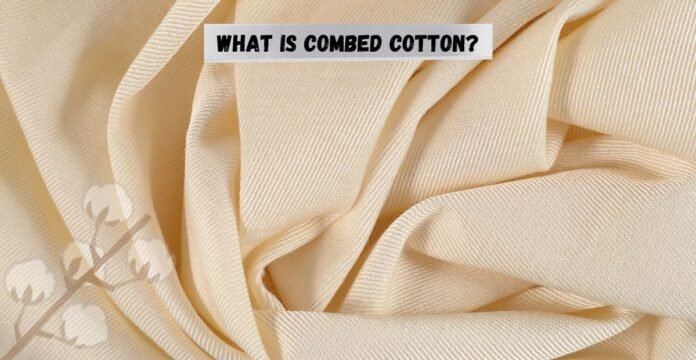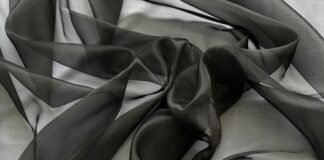Have you ever touched cotton that is especially soft and silky? That’s likely combed cotton. It is the premium brand that you will see on your favorite T-shirts and towels and bed sheets. The term can be technical but it merely indicates an exquisite type of cotton produced by an additional processing procedure.
Combed cotton is not only luxurious but also quality, comfortable as well as durable. Having a smoother feel, and a firmer yarn, it is now an item that has become a staple of brands and consumers who see quality in fabric performance.
This guide will answer the question as to what is combed cotton, how it is made, its advantages, and we will assist you in determining whether it is something to consider adding to your wardrobe and in your home textiles or not.
What is Combed Cotton?
To eliminate short and uneven fibers, manufacturers treat cotton. The cotton is then carded to remove the shorter fibres and contaminants. This particular combing process retains only the longest and strongest fibers. It yields a smoother, stronger and significantly softer yarn that is at variance with normal cotton. In more simple words, the combed cotton is just ordinary cotton that is refined to be smooth and soft. As a matter of fact, one of the sources refers to the combed cotton as a softer version of the normal cotton.
How Combed Cotton Is Made?
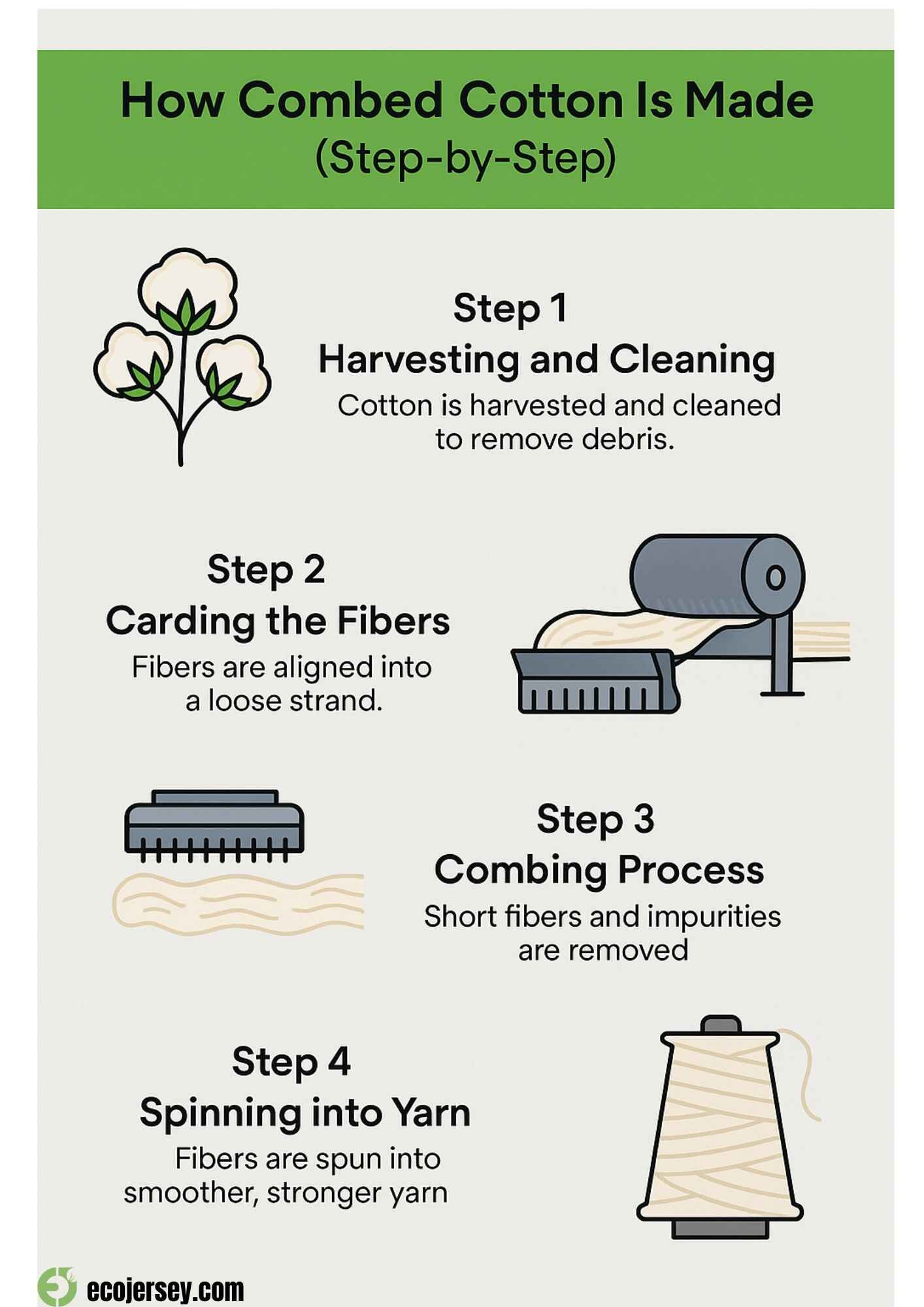
Step 1: Picking and tidying up the cotton.
During the first stage, the cotton bolls are picked and cleaned.. Machines help eliminate dirt, leaves, and seeds. Usually, a cotton gin removes seeds and debris from the raw fibers. After this, the remaining clean lint is processed.
Step 2: Carding the fibers
The next stage is cleaning the fibers. The cotton is carded using drums or brushes which smooth and loosely align the fibers in the same direction. The carding process also breaks up clumps and forms a thin web of fibers that is ready for combing.
Step 3: Combing – Removing the short fibers and impurities
After carding, the cotton fibers are combed using the finest, metal toothed combs. For instance, the combs remove the remaining short fibers and impurities. The fine combs are particularly designed for snaring the short strands and removing debris in order to leave the clean, long and straight fibers.
Step 4: Spinning the yarn to make it smoother and stronger
At last, the long combed fibers are spun into yarn. The spinning machines twist the aligned fibers to form a continuous thread. The yarn is also very strong and even because it is composed of said long, aligned fibers. It is subsequently knitted or woven into combed cotton fabric.
Benefits of Combed Cotton
Super Soft and Smooth Texture
Combed cotton feels extremely soft because all the short strands are removed. Combed cotton fabrics seem to be described as “notably softer than conventional cotton” time and again. To put this in other terms, the fabric feels almost silky, especially on bare skin. This ultra-smooth surface is the reason why combed cotton clothes and linens are considered to be more luxurious.
More Durable and Resistant to Pilling
Regular cotton is much weaker and combed cotton is tougher. Pilling is the formation of balls of fluff on the surface of the fabric. For example, one source explains that combed cotton is stronger because combing removes fibers that would otherwise break. This means, in short, combed cotton clothes hold up through many washes without developing lint balls or holes.
Less Likely to Fray or Tear
Because combed cotton’s fibers are long and well-aligned, it won’t easily fray or tear. Sciencing.com notes that after combing, the fibers “join together more tightly, leading to less fraying.” This means that the seams and edges of combed-cotton textiles will be intact much longer.
Holds Dye Better → Colors Are More Vivid
The fine, consistent, and uniform yarn of combed cotton absorbs dye evenly. One industry source contends that combing “improves dye absorption, producing richer and more vibrant colors”. Brightness and slow fading over time are distinguishing characteristics of combed-cotton garments and sheets.
Gentle on Skin (Good for People with Sensitive Skin)
Combed cotton is also very gentle on the skin. Global Textile Times describes that the absence of coarse fiber ends also contributes to making combed cotton “less prone to cause skin irritation”. That is the reason combed cotton is recommended for baby clothes and bedding.
Combed Cotton vs Regular Cotton
| Feature | Combed Cotton | Regular Cotton |
|---|---|---|
| Processing | Fibers are carded and combed; short fibers are removed. | Fibers are only carded; no combing step. |
| Fiber Quality | Mostly long, straight fibers; yarns are very even and fine. | Mix of long and short fibers; yarn is coarser. |
| Softness | Exceptionally soft and smooth due to fine yarn. | Standard cotton feel; can be a bit rougher. |
| Durability | Very strong and long-lasting; resists pilling and fraying. | Durable but short fibers can break; more likely to pill. |
| Color & Dye | Smooth fibers hold dye well for rich, long-lasting colors. | Less uniform; colors can fade faster. |
| Price | Higher (premium processing). | Lower (simpler manufacturing). |
For example, combed cotton is much softer and longer-lasting, but more expensive than regular cotton. This comparison shows why combed cotton is considered a premium fabric.
Combed Cotton vs Other Cotton Types
Combed vs Ring-Spun Cotton
“Ring-spun” indicates the method of yarn spinning while “combed” indicates the method of fiber preparation. A lot of the time, cotton can be combed and also ring-spun. Cotton is been combed first to remove the impurities, and then it is converted to ring-spun yarn. Ring-spun yarn, in isolation, is finer and stronger than basic yarn. In practice, ring-spun cotton is high-quality by itself, but combing the fibers first makes it even better.
Combed vs Organic Cotton
When cotton fabric is labeled as “organic” it has been grown without synthetic chemicals. But that does not guarantee the fabric was combed. Combed cotton means the fibers were processed after harvesting. For instance, you can have organic cotton that is also combed, or conventional combed cotton. For example, organic cotton is grown without pesticides. One source notes that while organic cotton is grown gently, it “may not be as strong as combed cotton”.
Difference between Combed Cotton and Egyptian Cotton
Egyptian cotton is one of the most luxurious and premium varieties as it has long fibers and a silky texture. Combed cotton is a reference to the processing, not a type. Furthermore, if the yarn made from Egyptian cotton is then combed, the outcome is considerably smoother. Overall, both terms suggest high quality: it is of Egyptian cotton, then it is the type of fiber, while it is combed, meaning extra processing has been done. In both scenarios, you get an exceptionally fine fabric.
Common Uses of Combed Cotton
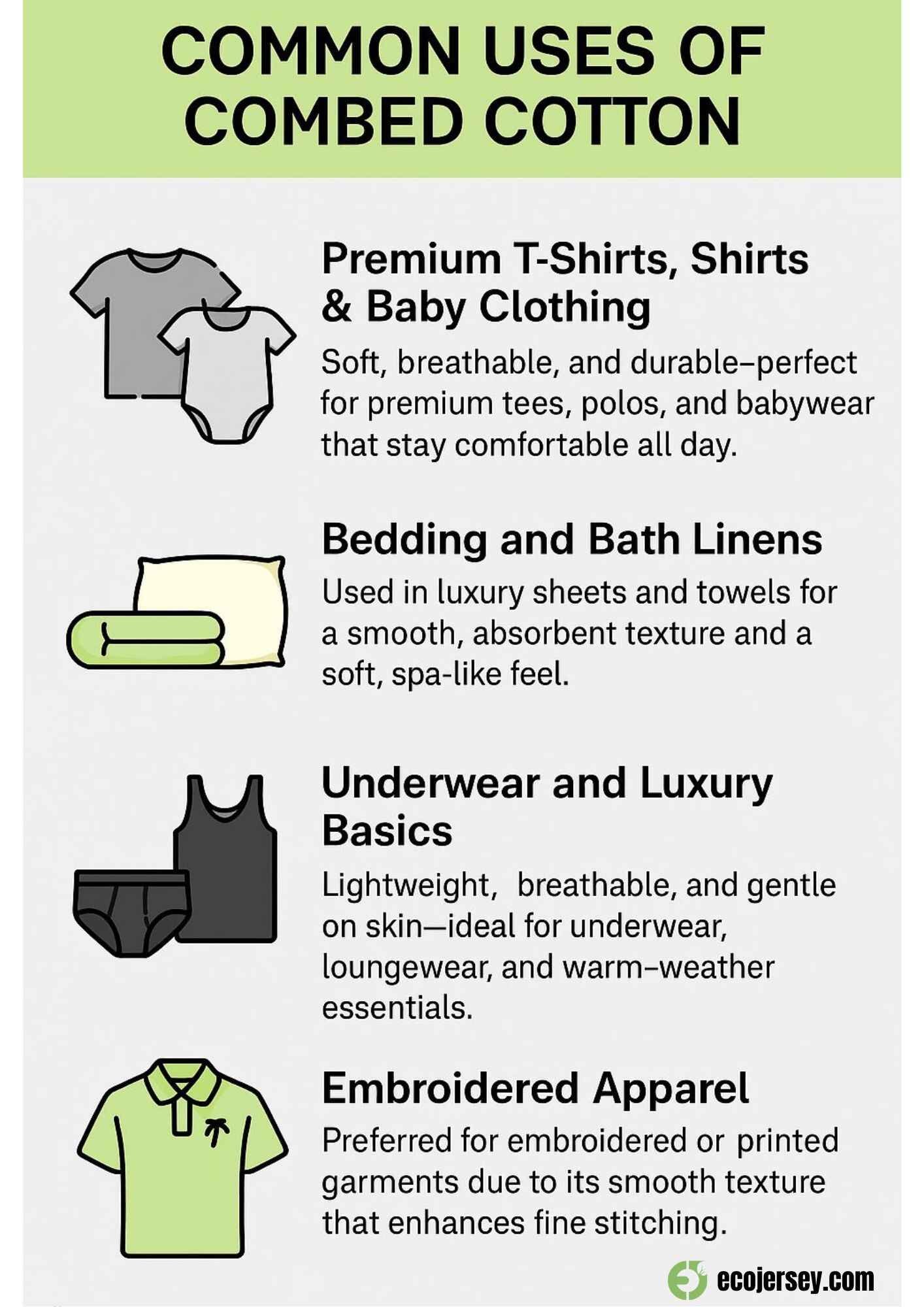
Premium T-Shirts, Shirts & Baby Clothing
Using combed cotton close to the skin is common practice. For Premium T-Shirts, polo shirts, and baby clothes combed cotton is useful for comfort. Soft and durable combed cotton yarns are used in embroidered polo shirts. In practice, many high-end tees and baby garments use combed cotton or its close equivalents.
Bedding and Bath Linens
Combed cotton is popular for bed linens and towels. Luxury sheets and towels often boast combed or long-staple cotton. If you have really soft sheets or plush towels, they were likely made from combed cotton. This super smooth cotton is soft and comfort is provides a wonderful experience sheathes after a shower or sleeping.
Underwear and Luxury Basics
Combed cotton is also used for lighter and everyday basics. It is lightly breathable and soft which makes it perfect warm-weather garments. Combed cotton is used in the summer T-Shirts and underwear. The smooth, well-spaced fibers provide ample breathability which is ideal for hot summer months.
Embroidered Apparel
Embroidered and uniform apparel is often made from combed cotton. For stitching and printing, smooth and uniform yarn is preferable. For example, Combed-cotton polos have such a consistent surface that logos and embroidery become more refined. In summary, combed cotton’s uniform surface is an advantage for any garment made for prints or stitching.
Is Combed Cotton Worth It?
- Price vs Quality Tradeoff: Even though combed cotton feels a little more expensive, the durability and comfort more than make up for the price. Consider it a long-term investment regarding quality and softness.
- Best for Those Seeking Comfort and Durability: If you want softness and strength for the long haul, combed cotton is the way to go. Even years down the line, it still stands up.
- Widely Available in Mid-Range Brands: The best part is that most mid-range brands have also incorporated combed cotton in their offerings which means that top-tier comfort is easier and cheaper to access than it has ever been.
How to Identify Combed Cotton Products
- Check the label. Find labels with claims of 100 per cent Combed Cotton, Super Combed or Long-Staple Combed. Combed cotton is usually emphasized in its brands. When it only says 100 percent cotton, with no reference to combing, it is probably ordinary cotton.
- Feel the fabric. Cotton is very smooth when it has been combed. Feel the stuff- is it smooth and smooth all the way through? then it is likely to be combed cotton. Ordinary cotton will feel a bit coarser or even fuzzier by comparison.
- Inspect the weave. The cotton fabrics are combed and are tightly and evenly woven with minimal surface fuzziness. In case of loose threads, or rough textured, it is probably not combed. Take care, also, of such alliterations as cotton-rich, which may conceal blends, but not necessarily combing.
Care Tips and Maintenance for Combed Cotton
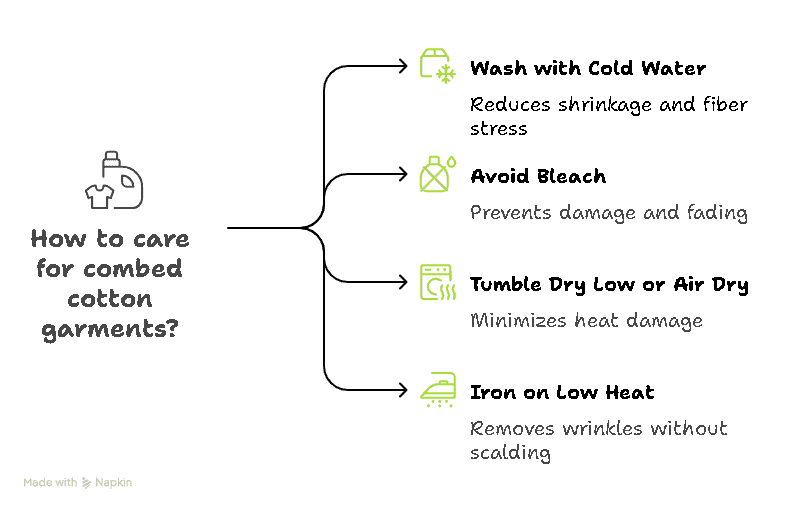
- Wash with cold or warm water (light cycle). Wash with a light detergent and light cycle. To reduce fiber stress and shrinkage, cold water is the best.
- Avoid bleach. Do not apply harsh chemicals or chlorine bleach. These are able to shred cotton strands and fade.
- Tumble dry low or air dry. Cotton can be damaged and made short as a result of high heat. Rather, have your combed-cotton things air-dried where possible. When dryer is being used; use low heat.
- Iron on low heat. The ironing should be done on a low-to-medium level in case it is required. Wrinkles in slightly damp garments made of combed cotton can be ironed without being scalded.
Conclusion-
To summarize, it does make ordinary cotton extraordinary by using combed cotton. It eliminates short fibers to come up with stronger, smoother and clearly more soft fabric. Combed cotton clothes and linen are more luxurious and long-lasting than ordinary cotton ones. The next time you go shopping check the label and find out whether it is a combed cotton. The secret of that extra-soft, high-grade feel.
Read More>> About “What is Mercerized cotton?“
FAQs
What does combed cotton mean?
It denotes that the cotton fibers are pulled (strands carded) to eliminate short and rough fibers. The long strong fibers are all that is left. More simply put, combed cotton is nothing more than regular cotton which has undergone refining to make it smooth and soft.
Is combed cotton better than regular cotton?
Generally, yes for comfort. Cotton is much smoother when it is combed and the touch of the material is much softer. Ordinary cotton is less expensive and very versatile, therefore, no need to worry in case money is the primary factor. According to many professionals, when luxury and softness are needed, combed cotton is the best choice.
Does combed cotton shrink?
Combed cotton, like any cotton, may shrink when exposed to high temperatures. Cold water is recommended to stay unshrunk and dry on the low level to prevent shrinkage. Light treatment will preserve clothes of cotton in their natural size and shape.
Is combed cotton good for hot weather?
Yes. Combed cotton is breathable, and lightweight therefore suitable in warm weather. Its fibers are well aligned and smooth which gives it a better airflow and moisture wicking. This is why it is frequently worn in summer T-shirts and underwear and other light clothes.

